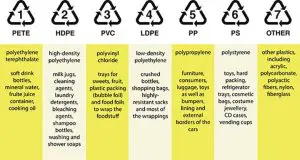Different Types of Plastic: How to Choose Your Promotional Merchandise Responsibly
When it comes to choosing promotional products for your business, one of the first questions we advise you ask your supplier is: ‘What is it made of?’
In many cases the product might be made of or contain plastic. In terms of environmental impact and toxicity not all plastic is created equally, therefore it is useful to know what the different types of plastic are so you can make informed choices about the products you choose.
Here are the 7 Different Types of Plastic (numbered according to their classification):
No #1: Polyetylene Terephthalate (PETE or PET): This is one of the most widely used plastics in the world and is likely the type used to make the plastic bottles or containers you use at home. PET is a form of polyester (just like the clothing fabric) and is highly valued as a packing material because it is non-reactive, lightweight and economical. Although products made with this type of plastic are recyclable, too often disposable bottles and the like end up in landfill. From a promotional products perspective, environmental concern has been partly responsible for the rise in popularity of reusable water bottles and keepcups, as PET products are typically intended for single-use applications only. PET plastic bottles and containers carry the #1 identification code.
No. #2: High-Density Polythylene (HDPE): Another hugely popular and economical plastic favoured for being lightweight, versatile and super strong is HDPE. This plastic carries the #2 identification code and is also fully recyclable. In fact, HDPE is the most commonly recycled plastic because it will not break under exposure to extreme heat or cold. This type of plastic is often selected for promotional products that will benefit from its sturdiness or as the cheaper alternative to some Low-Density Polyethylene (LDPE) products for example sports drink bottles.
No. #3: Polyvinyl Chloride (PVC): Despite being one of the oldest synthetic materials in industrial production it is probably the one with the worst reputation (dubbed by Greenpeace as the poison plastic). Although it can be found in a whole range of products (from children’s toys to name badges) it scores badly for being difficult to recycle and because it contains numerous toxins that are potentially harmful to both our health and the environment. PVC can be identified by the code #3
No. #4: Low-Density Polythylene (LDPE): LDPE was the first polyethylene to be produced (HDPE came later) and it’s a soft and flexible plastic that has a lower density than HDPE. Despite being soft it also strong which might explain why it’s the type of plastic they chose supermarket shopping bags to be made of. In terms of recycling, rigid LDPE products (such as containers, lids, caps) can be recycled easily whereas flexible LDPE products (such as bags and wraps) often need be recycled in the community (plastic bags at grocery stores for example) or end up in the regular trash if they are not reused. Promotional fabric and cloth bags are a great way to cut down on the amount of LDPE you/your customers consume.
No. #5: Polypropylene (PP): Polypropylene plastic is tough and lightweight and acts as an excellent barrier against grease, moisture and chemicals (which is why it is used as a liner for cereal boxes or to keep your potato chips fresh). Although safe to reuse, PP is not accepted in council collections and from an environmental perspective poses a significant threat (hence the push to ban products such as single-use plastic straws). This type of plastic has also resulted in microplastic fibre pollution which has had a negative impact on ocean marine life.
No. #6: Polystyrene or Styrofoam (PS): This light, structurally-weak plastic is found in products such as foam cups, take-away containers and picnic cutlery. PS breaks easily making it environmentally hazardous and not generally recommended. Whilst re-useable cups, stainless steel takeaway containers and compostable picnic cutlery are good replacements, don’t forget to be mindful of the packaging your promo merchandise comes in – The “peanut” foam chips used to fill shipping boxes to protect the contents are also made of PS.
No. #7: Other Miscellaneous Plastics (BPA, Polycarbonate and LEXAN): This category of plastics is a catch-all for all “other” plastics and there is no set standard when it comes to the reuse/recycling of these products. No.7 plastics are used to make baby bottles, sippy cups and plastic containers amongst other things. You are strongly advised to avoid using polycarbonate containers made using BPA (Bisphenol A) which can have possible harmful health effects on infant and young children. The compostable plastics they have been developed to replace polycarbonates also fall into the #7 plastics category (which is confusing). These plastics have the initials “PLA” on them near the recycling symbol and are the only ones in this category that are intended for reuse.
Good to Know: The well-recognised “chasing arrows” symbols we see on plastic products is to help consumers identify the type of plastic. This symbol does not mean all these products are reusable/recyclable.
The 7 Types of Plastic (Image via: learn.eartheasy.com )
The Good News? Promotional Products and Branded Merchandise don’t need to be confusing. At Inck we are here to make your life EASY. So, give us a call and let us take care of the rest!

